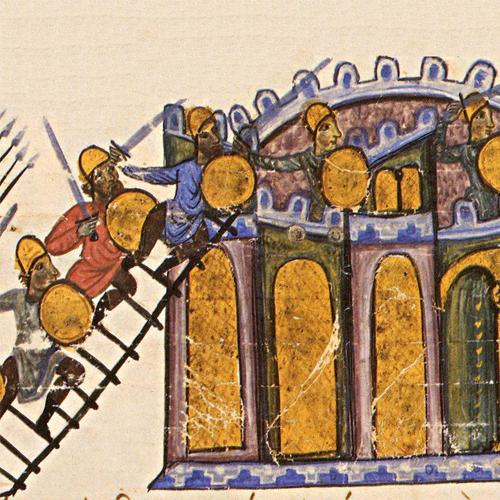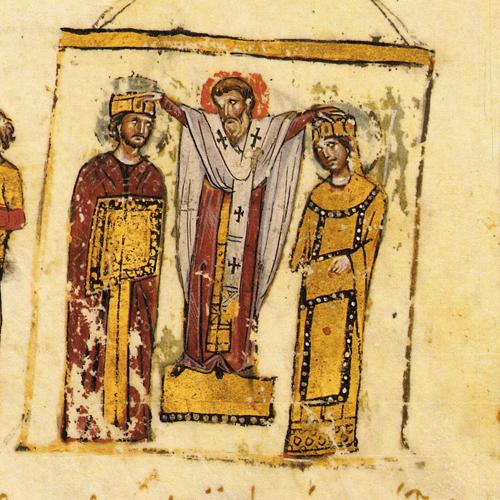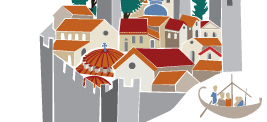Thessaloniki through the eyes of 12th century Byzantine writers
 Throughout the Byzantine period Thessaloniki played an indisputably important role in the life of the empire. Its strategic position at the crossroads of the major trade routes in the Balkan Peninsula, and its harbor, which was a key source of wealth down the centuries, rendered it the second largest city in the Empire after the capital Constantinople. From the third century on, when it became the seat of Galerius, one of the co-emperors of the Tetrarchy, Thessaloniki was adorned with an imperial palace and several opulent, imposing, public and private buildings, thus ushering in a lengthy period of prosperity that directly influenced the city’s form and development. The city retained the ground lines of the Roman town plan for centuries; the main... Listen | Download | Print
Throughout the Byzantine period Thessaloniki played an indisputably important role in the life of the empire. Its strategic position at the crossroads of the major trade routes in the Balkan Peninsula, and its harbor, which was a key source of wealth down the centuries, rendered it the second largest city in the Empire after the capital Constantinople. From the third century on, when it became the seat of Galerius, one of the co-emperors of the Tetrarchy, Thessaloniki was adorned with an imperial palace and several opulent, imposing, public and private buildings, thus ushering in a lengthy period of prosperity that directly influenced the city’s form and development. The city retained the ground lines of the Roman town plan for centuries; the main... Listen | Download | Print
Once upon a time in Byzantium…
 Once upon a time, in a country with the name Byzantium, lived a young prince, named Andronikos. He couldn’t remember his mother as she died at birth and his father, the king, married for a second time a woman with the same name, Eleni, who was very ambitious and smart. When all of a sudden his father died, Andronikos was just an adolescent, and his step mother, Eleni, would reign until the day the young price would be old enough to take over the throne.She loved Andronikos because he was a smart and nice boy, he cared about him and wanted him to become a good emperor, just like his father. But Eleni was very worried about the woman that would stand by his side when he would get married and about how the two women would coexist in the palace. One day though, Eleni realized that she couldn’t delay things any more. Listen | Download | Print
Once upon a time, in a country with the name Byzantium, lived a young prince, named Andronikos. He couldn’t remember his mother as she died at birth and his father, the king, married for a second time a woman with the same name, Eleni, who was very ambitious and smart. When all of a sudden his father died, Andronikos was just an adolescent, and his step mother, Eleni, would reign until the day the young price would be old enough to take over the throne.She loved Andronikos because he was a smart and nice boy, he cared about him and wanted him to become a good emperor, just like his father. But Eleni was very worried about the woman that would stand by his side when he would get married and about how the two women would coexist in the palace. One day though, Eleni realized that she couldn’t delay things any more. Listen | Download | Print
Building a Byzantine fortified city
 From a researcher’s point of view, if archaeological finds bear tangible witness to aspects of life in Byzantine times, manuscripts represent a distinct, valuable source of knowledge as they preserve a wealth of information on events, historical persons and their works. Written by scholars or ordinary folk, emperors, ecclesiastical or secular dignitaries, such texts document moments in Byzantine history and culture as it unfolded in the territories of the empire. A treatise was written in the 6th century by an army engineer. Among other things, he provides readers with particularly interesting guidelines on the construction of fortifications and siege engines. Listen | Download | Print
From a researcher’s point of view, if archaeological finds bear tangible witness to aspects of life in Byzantine times, manuscripts represent a distinct, valuable source of knowledge as they preserve a wealth of information on events, historical persons and their works. Written by scholars or ordinary folk, emperors, ecclesiastical or secular dignitaries, such texts document moments in Byzantine history and culture as it unfolded in the territories of the empire. A treatise was written in the 6th century by an army engineer. Among other things, he provides readers with particularly interesting guidelines on the construction of fortifications and siege engines. Listen | Download | Print



